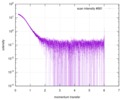[English] 日本語
 Yorodumi
Yorodumi- SASDCA7: Ethylene Receptor 1 (DHp + CA domains) (Ethylene receptor 1 dimer... -
+ Open data
Open data
- Basic information
Basic information
| Entry |  |
|---|---|
 Sample Sample | Ethylene Receptor 1 (DHp + CA domains)
|
| Function / homology |  Function and homology information Function and homology informationethylene receptor activity / regulation of seedling development / detection of ethylene stimulus / ethylene binding / defense response by callose deposition in cell wall / negative regulation of ethylene-activated signaling pathway / sugar mediated signaling pathway / seed dormancy process / phloem or xylem histogenesis / response to insect ...ethylene receptor activity / regulation of seedling development / detection of ethylene stimulus / ethylene binding / defense response by callose deposition in cell wall / negative regulation of ethylene-activated signaling pathway / sugar mediated signaling pathway / seed dormancy process / phloem or xylem histogenesis / response to insect / response to gibberellin / cytokinin metabolic process / response to ethylene / regulation of stomatal movement / protein histidine kinase activity / response to auxin / response to abscisic acid / hydrogen peroxide biosynthetic process / phosphorelay sensor kinase activity / histidine kinase / response to salt stress / defense response / response to molecule of bacterial origin / response to heat / defense response to bacterium / cell division / endoplasmic reticulum membrane / endoplasmic reticulum / ATP binding / metal ion binding / identical protein binding Similarity search - Function |
| Biological species |  |
 Citation Citation |  Journal: J Biol Chem / Year: 2015 Journal: J Biol Chem / Year: 2015Title: Structural model of the cytosolic domain of the plant ethylene receptor 1 (ETR1). Authors: Hubert Mayerhofer / Saravanan Panneerselvam / Heidi Kaljunen / Anne Tuukkanen / Haydyn D T Mertens / Jochen Mueller-Dieckmann /  Abstract: Ethylene initiates important aspects of plant growth and development through disulfide-linked receptor dimers located in the endoplasmic reticulum. The receptors feature a small transmembrane, ...Ethylene initiates important aspects of plant growth and development through disulfide-linked receptor dimers located in the endoplasmic reticulum. The receptors feature a small transmembrane, ethylene binding domain followed by a large cytosolic domain, which serves as a scaffold for the assembly of large molecular weight complexes of different ethylene receptors and other cellular participants of the ethylene signaling pathway. Here we report the crystallographic structures of the ethylene receptor 1 (ETR1) catalytic ATP-binding and the ethylene response sensor 1 dimerization histidine phosphotransfer (DHp) domains and the solution structure of the entire cytosolic domain of ETR1, all from Arabidopsis thaliana. The isolated dimeric ethylene response sensor 1 DHp domain is asymmetric, the result of different helical bending angles close to the conserved His residue. The structures of the catalytic ATP-binding, DHp, and receiver domains of ethylene receptors and of a homologous, but dissimilar, GAF domain were refined against experimental small angle x-ray scattering data, leading to a structural model of the entire cytosolic domain of the ethylene receptor 1. The model illustrates that the cytosolic domain is shaped like a dumbbell and that the receiver domain is flexible and assumes a position different from those observed in prokaryotic histidine kinases. Furthermore the cytosolic domain of ETR1 plays a key role, interacting with all other receptors and several participants of the ethylene signaling pathway. Our model, therefore, provides the first step toward a detailed understanding of the molecular mechanics of this important signal transduction process in plants. |
 Contact author Contact author |
|
- Structure visualization
Structure visualization
- Downloads & links
Downloads & links
-Data source
| SASBDB page |  SASDCA7 SASDCA7 |
|---|
-Related structure data
| Related structure data |  4mt8C  4mtxC  4pl9C C: citing same article ( |
|---|---|
| Similar structure data | Similarity search - Function & homology  F&H Search F&H Search |
- External links
External links
| Related items in Molecule of the Month |
|---|
-Models
- Sample
Sample
 Sample Sample | Name: Ethylene Receptor 1 (DHp + CA domains) / Dry vol: 33262 / Specimen concentration: 0.60-6.00 / Concentration method: A280 |
|---|---|
| Buffer | Name: 20 mM Tris 150 mM NaCl 1 mM DTT 5 mM ADP / pH: 8.8 |
| Entity #778 | Name: ETR1_DHp-CA / Type: protein Description: Ethylene receptor 1 dimerization histidine phosphotransfer + catalytic ATP-binding domains Formula weight: 27.492 / Num. of mol.: 2 / Source: Arabidopsis thaliana / References: UniProt: P49333 Sequence: TAIRARNDFL AVMNHEMRTP MHAIIALSSL LQETELTPEQ RLMVETILKS SNLLATLMND VLDLSRLEDG SLQLELGTFN LHTLFREVLN LIKPIAVVKK LPITLNLAPD LPEFVVGDEK RLMQIILNIV GNAVKFSKQG SISVTALVTK SDTRAADFFV VPTGSHFYLR ...Sequence: TAIRARNDFL AVMNHEMRTP MHAIIALSSL LQETELTPEQ RLMVETILKS SNLLATLMND VLDLSRLEDG SLQLELGTFN LHTLFREVLN LIKPIAVVKK LPITLNLAPD LPEFVVGDEK RLMQIILNIV GNAVKFSKQG SISVTALVTK SDTRAADFFV VPTGSHFYLR VKVKDSGAGI NPQDIPKIFT KFAQTQSLAT RSSGGSGLGL AISKRFVNLM EGNIWIESDG LGKGCTAIFD VKLGISERSN E |
-Experimental information
| Beam | Instrument name:  DORIS III X33 DORIS III X33  / City: Hamburg / 国: Germany / City: Hamburg / 国: Germany  / Shape: 0.6 / Type of source: X-ray synchrotron / Wavelength: 0.154 Å / Dist. spec. to detc.: 3.1 mm / Shape: 0.6 / Type of source: X-ray synchrotron / Wavelength: 0.154 Å / Dist. spec. to detc.: 3.1 mm | ||||||||||||||||||||||||||||||||||||||||||||||||
|---|---|---|---|---|---|---|---|---|---|---|---|---|---|---|---|---|---|---|---|---|---|---|---|---|---|---|---|---|---|---|---|---|---|---|---|---|---|---|---|---|---|---|---|---|---|---|---|---|---|
| Detector | Name: Pilatus 1M-W / Pixsize x: 0.172 mm | ||||||||||||||||||||||||||||||||||||||||||||||||
| Scan |
| ||||||||||||||||||||||||||||||||||||||||||||||||
| Distance distribution function P(R) |
| ||||||||||||||||||||||||||||||||||||||||||||||||
| Result |
|
 Movie
Movie Controller
Controller







